Whenever you hear about Monsteras, you tend to think of them as all having large, dramatic foliage with their famous striking splits and holes, called fenestrations. This is where they get their other common name of the Swiss Cheese Plant, after all.
But there are actually a number of different types of Monstera. While all have variations of the split leaves that this plant is so famous for, these Monstera varieties actually differ from one another much more than you may expect.
And if you’re turning into a bit of a houseplant collector, this will hopefully be good news. That is, Monsteras certainly make a striking display and their popularity in recent years is almost definitely due to their unique appearance and relatively easy care.
So if you can add several of the most popular types of Monstera to your collection, with their differing looks and characteristics, then this can really add to the uniqueness of your plant family.
And even if you’re new to Monsteras, there’s no need to always go for the tried and true Monstera deliciosa, as there could be another one that’s perfect for your home or office. So keep reading to find some options in this list of Monstera varieties (with pictures and names!) for the next addition to your houseplant collection!
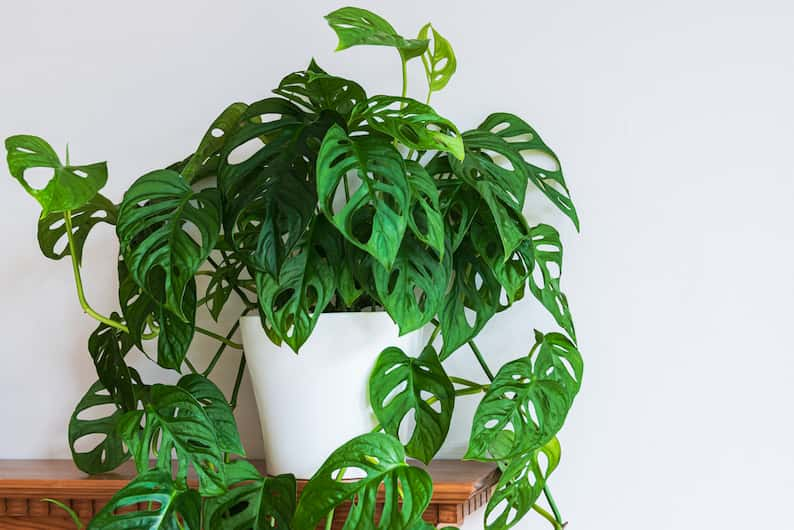
Table of Contents
Most popular types of Monstera
1. Monstera deliciosa
Monstera deliciosa is the most popular type of Monstera plants. It can be found at florists, supermarkets, and plant centers. This plant is prized for its dramatic foliage and its ability to grow in low to medium light.
The leaves on Monstera deliciosa have both splits and holes. These holes typically appear first and work their way to the edges of the leaves, forming dramatic splits. Therefore, leaves on a Monstera deliciosa plant may have holes and splits on the same plant.
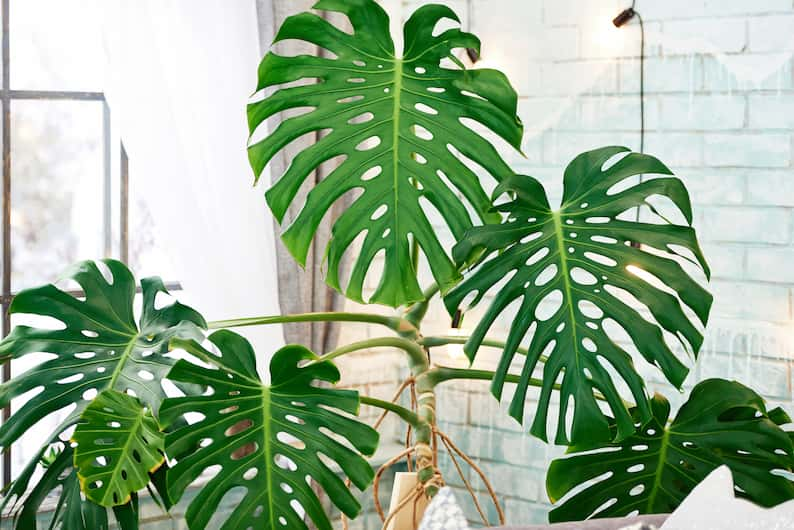
This type of Monstera is often confused with split-leaf philodendrons as they have similar appearances. However, a distinguishing feature of Monstera deliciosa is that the leaves have holes as well as splits, while the split-leaf philodendron’s foliage lacks holes.
In terms of Monstera deliciosa care, they prefer bright, indirect light but will tolerate low light. It likes rich, well-drained soil and can be grown in an aroid potting soil mix. Just make sure that you only water your plant when the soil feels dry 1 to 2 inches below the surface to avoid your Monstera deliciosa becoming overwatered.
2. Monstera adansonii
Monstera adansonii, sometimes incorrectly labeled as Monstera friedrichsthalii, is smaller than Monstera deliciosa, but don’t let its smaller size fool you into thinking it is less showy. This Monstera variety has lacy holes that can take up close to 50 percent of the leaf surface, making it a striking specimen for either the home or office.
Monstera adansonii grows to 3 to 5 feet and is an excellent plant for hanging baskets or grown in pots where it is allowed to cascade over the sides of the pot. In the office, it makes a delightful plant on top of bookcases or filing cabinets.
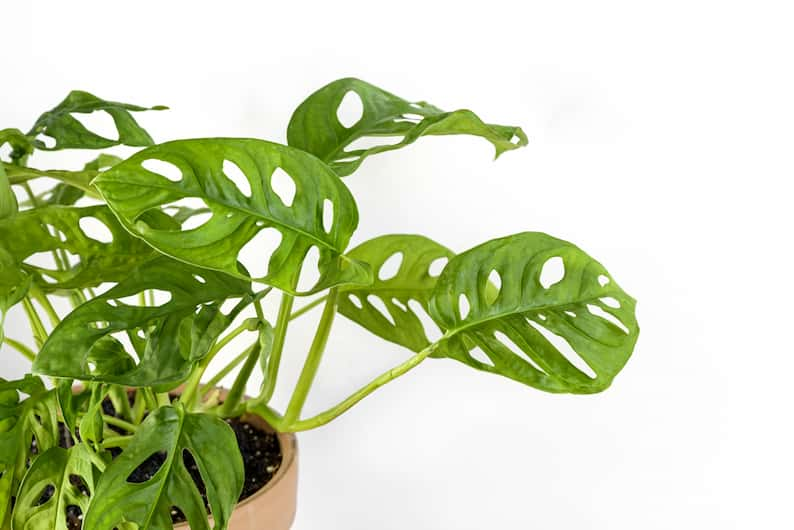
The foliage on Monstera adansonii is typically solid green, but there are some variegated varieties. This plant tolerates low light, but beware. Variegated varieties may stop producing variegated leaves and revert to solid green leaves if they are grown in low light.
When it comes to Monstera adansonii care, grow them in bright indirect light and water it when the soil feels dry 1 to 2 inches below the surface. Avoid over watering as this can lead to root rot in Monsteras.
3. Monstera borsigiana
Monstera borsigiana, also called Wrinkle Monstera, is a type of Monstera deliciosa. Like other Monsteras, it produces foliage with dramatic holes and splits as it matures. Young leaves are often heart-shaped and green. While many are solid green, Monstera borsigiana ’albo’ produces lovely, variegated leaves.
Grow Monstera borsigiana on a moss-covered pole or totem in bright, indirect light for best results. Variegated Monstera varieties may lose their striking variegation if grown in low light as the plant will produce more solid green leaves in order to capture light and perform photosynthesis.
If your variegated Monstera begins to lack variegation, move it to an area where it will receive more light to encourage the growth of variegated leaves.
4. Monstera lechleriana
Monstera lechleriana produces large 10-inch leaves with holes near the center and splits along the outer edges of the leaves. Foliage is dark green and fans out as the plant matures. This is one of the quicker growing Monster varieties, reaching heights of over 20 feet in the wild but typically growing up to three feet as a houseplant.
It does best with a moss-covered pole or totem to climb and makes an attractive floor plant. In particular, consider adding this type of Monstera to an office or waiting room to add a tropical feel to the area or add privacy in seating areas.
Grow Monstera lechleriana in bright filtered light but avoid direct sunlight as it can result in the delicate leaves on your Monstera being sunburnt. Water it when the soil feels dry 1 to 2 inches below the surface and fertilize your Monstera once or twice a month from spring until fall when it is actively growing.
5. Monstera albo
Monstera Albo Deliciosa, also known as Monstera ‘White Tiger’ or Monstera deliciosa ‘Albo Variegata,’ is a variegated Monstera with bright white variegation. The striking foliage is sometimes more white than green with dramatic split edges and holes in the center.
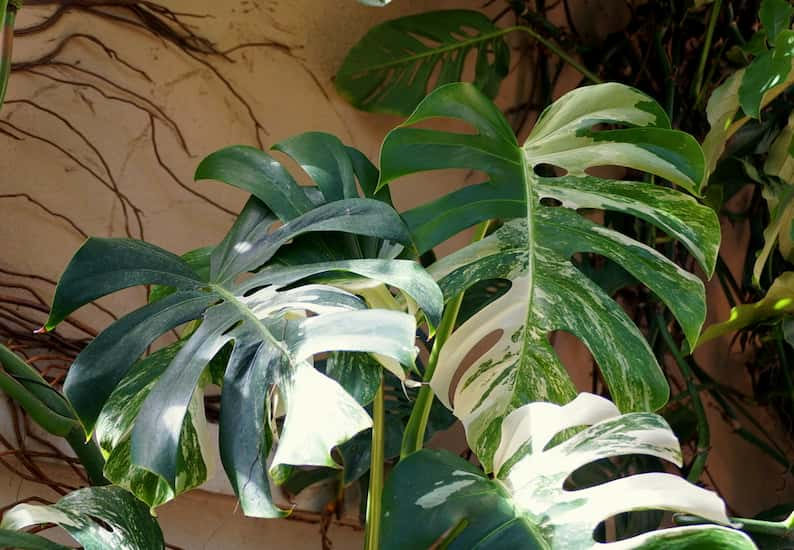
This rare Monstera variety produces mature leaves that reach a size of 12 to 15 inches. It needs bright, indirect light for 6 hours a day. Like other variegated varieties, low light conditions will cause plant growth to slow, and new leaves on your Monstera will be smaller and solid green.
The variegated portions of the leaves lack chlorophyll and cannot use the sun’s light to perform photosynthesis and produce energy for the plant. If you’re not able to meet this Monstera’s light requirements, the plant will adapt by producing solid green leaves in an attempt to effectively use the light it receives.
6. Monstera esqueleto
Monstera esqueleto, also called Monstera epipremnoides, is one of the smaller Monstera varieties, but don’t let that fool you into thinking it is less showy than its larger cousins. It produces large holes in the leaves that take up nearly half of the leaf space giving it a lacy appearance.
Each leaf has its own unique pattern of fenestrations ranging from small to large holes scattered over the leaves. This adds to the beauty of the plant as its appearance is ever-changing as it grows and matures.
Grow Monstera esqueleto in bright indirect sunlight. Morning light from a northern or eastern window works well. If grown near a southern or western window, your Monstera esqueleto will need a sheer curtain to filter the light.
In terms of how often to water this Monstera, you should do so when the soil feels dry 1 to 2 inches below the surface and then let the soil dry again. Always remember to empty saucers and drip trays after watering your Monstera to avoid soggy soil sitting in the pot.
What is the difference between Monstera Adansonii and Monstera esqueleto?
The main difference between Monstera Adansonii and Monstera esqueleto is in the fenestration of their leaves, with Monstera esqueleto having much larger holes. Monstera Adansonii also tends to have smaller leaves that are a darker shade of green than Monstera esqueleto.
It’s also worth mentioning that one of the main differences between these types of Monstera is the price. A Monstera Adansonii will be significantly cheaper than a Monstera esqueleto, with the latter easily being more than $100, if not more, in most shops. This largely comes down to the fact that it’s generally harder to find, so while you’ll pay a pretty penny for it, your new Monstera epipremnoides will give you a much more unique plant.
But given how similar these two Monster varieties are, I’ll leave it to you to determine if the added price is worth it.
7. Monstera siltepecana
Monstera siltepecana, also known as the Silver Monstera, is prized for its unique coloration. Leaves are deep green with silvery patterns throughout. Monstera el Salvador is remarkably similar to Monstera siltepecana but has larger leaves.
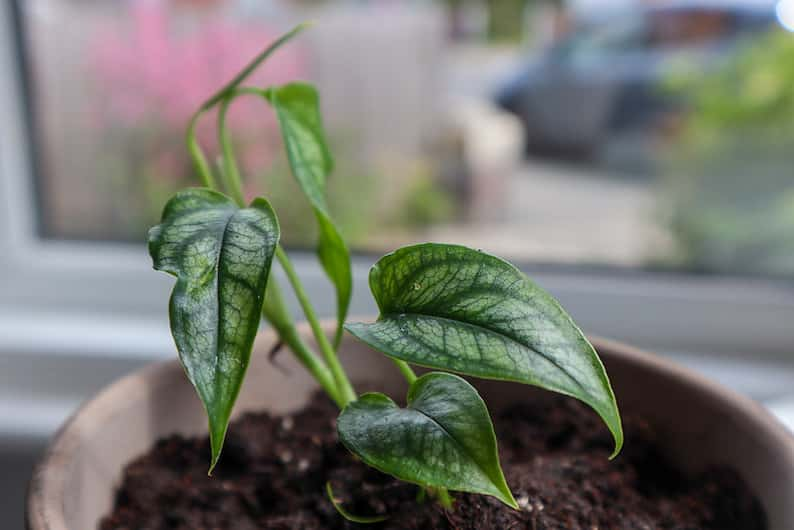
This Monstera variety displays two distinct types of leaves. When it is young, the leaves are small and lance-shaped and lack fenestrations. Fenestrations appear on new leaves as the plant matures transforming the appearance of the plant.
Like other types of Monstera plants, the Silver Monstera prefers bright, indirect light and evenly moist soil. Water it when the soil feels dry 1 to 2 inches below the surface and allow it to dry out slightly before watering it again.
8. Monstera Peru
Monstera Peru is a rare and unique Monstera that does not have the characteristic fenestrations of other Monsteras. This means that it’s one of the few types of Monsteras whose leaves don’t split. Instead, it is prized for its glossy green leaves with deep green veins. The veins become more pronounced as the plant matures.
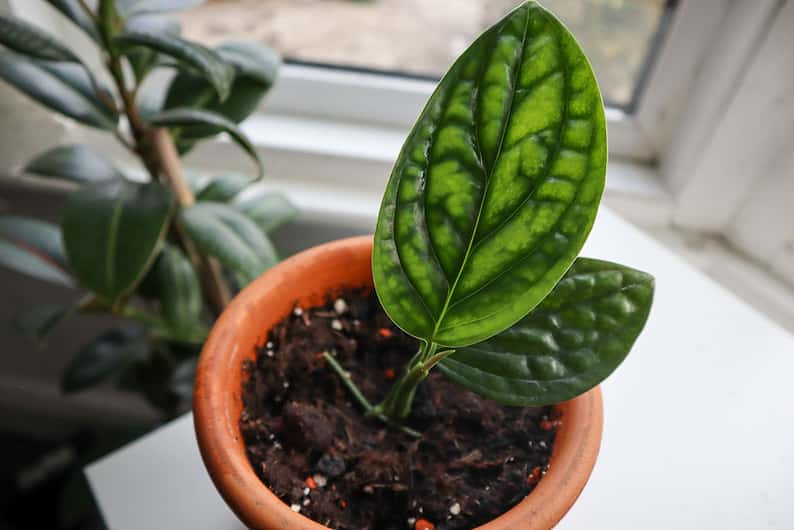
Although they are reported as small Monsteras that only reach a foot or two as houseplants, these plants are best grown on a moss-covered pole or trellis to show off their dramatic leaves.
Grow Monstera Peru in bright, indirect sunlight and water it when the soil dries 1 to 2 inches below the surface. It may need watering once or twice a week from spring until fall when it is actively growing.
9. Monstera standleyana
Monstera standleyana, sometimes called the 5 Hole Plant, is a variegated Monstera that may have splashes, stripes, or speckles of white, cream, or yellow against deep green. It grows to heights of 2 to 3 feet as a houseplant and produces 6-to-8-inch leaves.
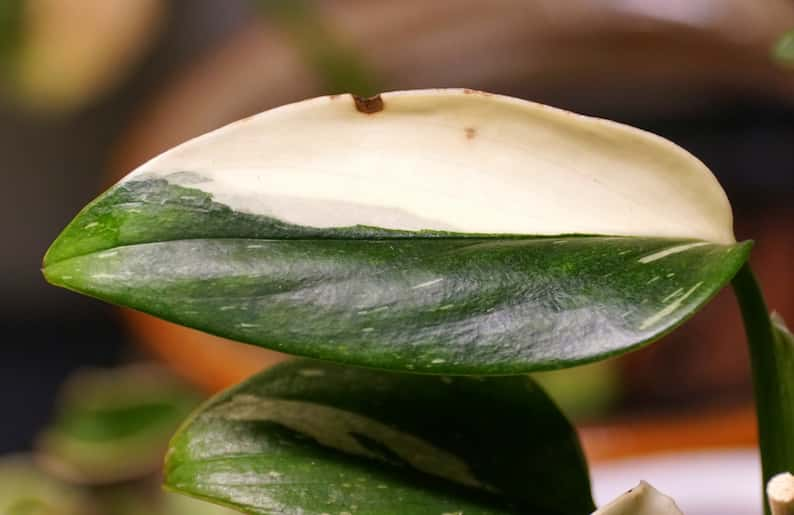
It prefers bright, indirect, or filtered light and will show signs of delayed growth or a lack of variegation if grown in low light. As this is a climbing Monstera variety, it does best with support from a moss pole or totem.
Water Monstera standleyana when the soil feels dry 1 to 2 inches below the surface and let it dry out again before watering it again. It requires frequent watering during the spring and summer when it is actively growing, but its water needs decrease in fall and winter when it rests.
10. Monstera obliqua
This type of Monstera plant is so unique it is often called the Unicorn Plant, but don’t let the name fool you. Monstera obliqua is not a myth. This plant produces showy leaves that are said to be nearly 90 percent holes.
But don’t set your heart on growing Monstera obliqua at home unless you are an experienced horticulturist. The foliage is wafer-thin and far too delicate for growing in the average home.
These rare Monstera varieties can be found in botanical gardens but are rarely seen at florists and other plant outlets. You may find Monstera obliqua plants for sale on rare plant sites or in rare plant auctions.
11. Monstera laniata
Monstera laniata is a common type of Monstera plant that is a sub-species of Monstera adansonii. This Monstera produces narrow, green leaves when it is young, but the leaves develop distinctive fenestrations as it matures. Holes in the leaves of Monstera laniata remain closer to the center than those of other Monstera adansonii plants.
Like other Monstera varieties, Monstera laniata prefers bright indirect light and will suffer in the direct rays of the sun. Grow it near an eastern or northern window or across the room from western or southern windows.
Water your Monstera laniata when the soil feels dry 1 to 2 inches below the soil and let it dry again before watering. Avoid over watering as Monstera plants are susceptible to root rot from soggy soil. Like most plants in this family, using the best soil possible for Monsteras can help to avoid those kinds of issues.
12. Monstera pinnatipartita
Monstera pinnatipartita produces leaves that are deeply lobed with the splits going almost to the center vein of the leaf. Its leaves take on a feathered appearance instead of the Swiss Cheese appearance Monsteras are known for.
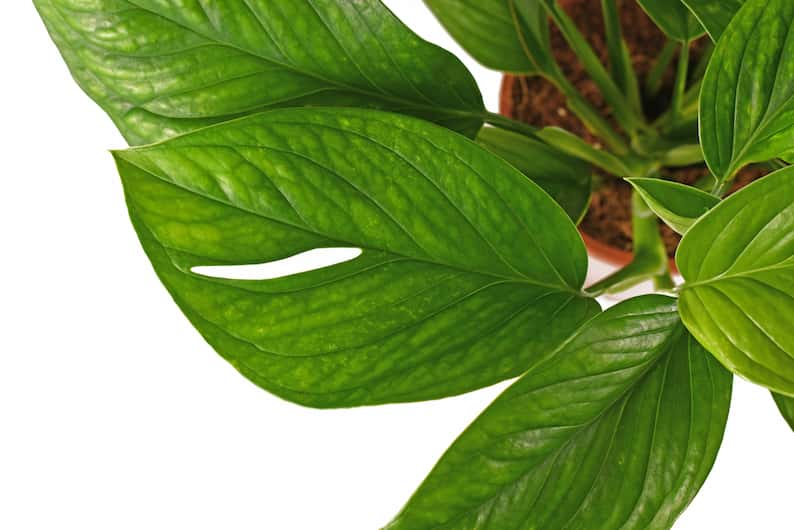
Juvenile leaves may be bicolored with silvery splashes but are solid and do not have splits or holes. Leaves develop fenestrations and take on the feathered effect as the plant matures.
Make sure you stake your Monstera pinnatipartita by growing it on a moss-covered pole in a location where it will receive bright indirect light. It will grow in less light, but leaves may remain in the juvenile stage if the plant does not receive enough light.
13. Monstera dubia
Monstera dubia is known as the Shingle Plant due to the unique growing habits of juvenile plants. Leaves are heart-shaped with splashes of light green against a deeper green background.
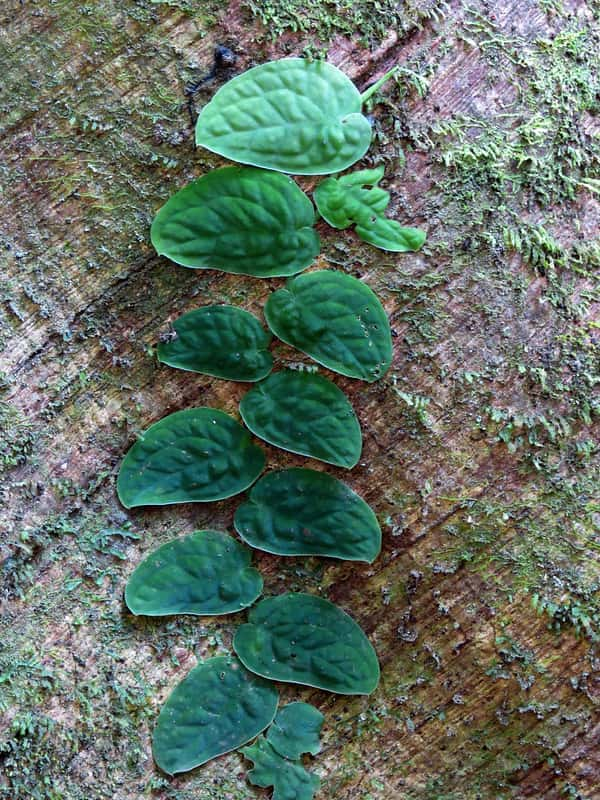
When grown on a totem or moss pole, this popular Monstera variety creeps up the pole holding the leaves snugly against the pole giving the illusion of shingles. When these Monstera are in the wild, the leaves eventually mature and develop holes and splits, but those grown as houseplants typically remain in the juvenile stage.
Grow Monstera dubia in bright indirect light and water it when the soil feels dry 1 to 2 inches below the surface. Fertilize it once or twice a month from spring until fall when it is actively growing.
Did you know: Some people consider the Monstera tuberculata to be a different Monstera variety from the dubia, while other experts say they’re actually clones of one another.
14. Monstera Thai Constellation
Monstera Thai Constellation is a variegated Monstera that doesn’t exist in the wild. It was developed in a lab with tissue cultures, creating a stunning variety with speckles and splotches that look like stars in the night sky.
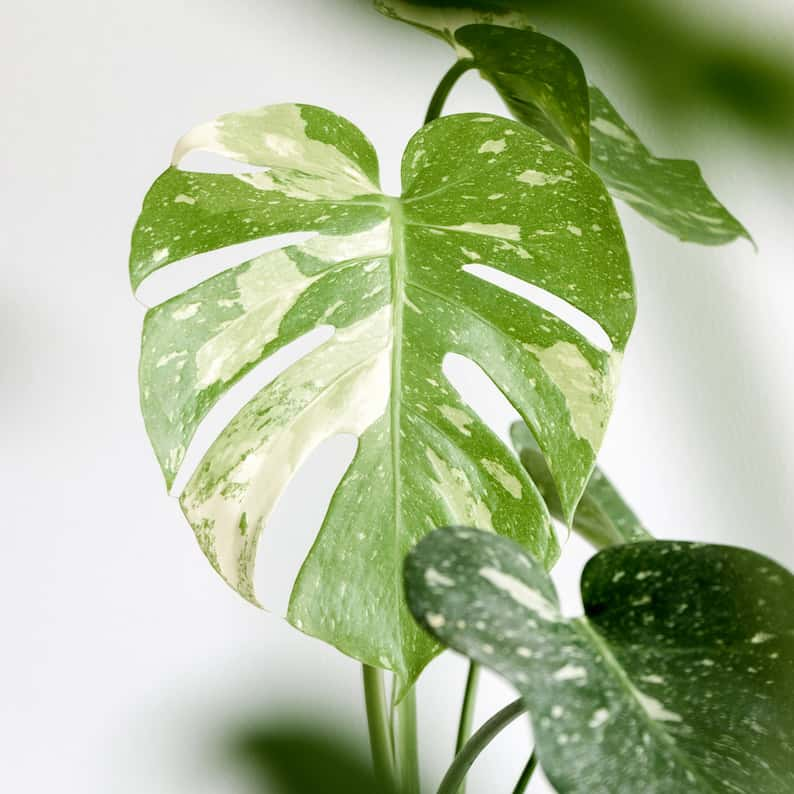
Variegation in Thai Constellation can be in shades of cream, yellow or white against a dark green background. It has pronounced fenestrations that include both dramatic splits and holes.
Like other Monstera plants, Thai Constellation needs well-drained soil that is allowed to dry out slightly between waterings. It prefers bright, indirect light from a northern or eastern window. Otherwise, it must be placed several feet from western or southern windows to avoid the direct sun.
15. Monstera subpinnata
Monstera subpinnata is a great alternative to what you may imagine a more typical Monstera plant to look like. That is, you wouldn’t be blamed for thinking all Monstera have the large, heart shaped leaves with those unique splits that they’re known for.
But in case you can’t tell from this list, that’s not the case for all of them. And Monstera subpinnata really mixes it up with its long, lance-like leaflets. The splits here make it seem like one leaf is actually a dozen, so it adds a whole new idea to what a typical Monstera variety actually is.

16. Monstera aurea
Monstera Aurea is a truly stunning variegated type of Monstera. Most people think of the Thai Constellation when it comes to the typical Monstera variegata, but the Aurea throws another card into the mix.
The golden yellow flecks across its leaves offer a truly stunning addition to your home and there’s no doubt that this Monstera variety will be a show stopper in any room you put it in.
17. Monstera acuminata
Monstera Acuminata is often confused with the adansonii – and that’s perfectly understandable given their leaves are very hard to distinguish from one another, especially as juveniles.
But this beautiful Monstera variety shouldn’t be dismissed as simply a knock-off adansonii, as it can certainly stand on its own two feet…or, well, its aerial roots. Its deep green leaves and slightly more dainty apertures than you often find in other members of this plant family make it a great addition to any home or office.
18. Monstera acacoyaguensis
The Monstera acacoyaguensis is certainly on the rarer side but are increasing in popularity, pushing prices up accordingly. This may be because they’re like a combination of the larger leaves you’ll find in other types of Monstera, but with the larger fenestrations you’d typically find in, say, the adansonii.
Fortunately, they’re just as easy to care for as their Monstera cousins and can really make a statement in a room.
19. Monstera spruceana
The Monstera spruceana really takes this plant family’s famous fenestrations to the next level, with huge holes in its leaves that are more like cuts spreading from each inner leaf’s stem. In fact, it can almost give the impression that each leaflet is its own leaf itself.
These are relatively rare Monstera varieties, although their increasing popularity means they’re also becoming increasingly more available in specialty garden shops and certain online sellers. With many similarities to the Monstera subpinnata, it could offer something different to your Monstera collection.
20. Monstera dissecta
And while we’re on the topic of types of Monstera that look similar to one another, the Monstera dissecta is also often confused for either the spruceana or subpinnata.
With large, feather-like leaves, you wouldn’t be blamed for mixing each of them up – although, as our article at the link above will show you, there is a telltale sign that makes it easier to identify the dissecta.
21. Monstera sierrana
At first glance, many see the Monstera sierrana and think it’s the more common deliciosa. However, look closer and you’ll start to see differences in their leaves, with the far rarer sierrana not having the smaller holes you’ll find in the deliciosa’s foliage.
A highly sought after Monstera variety, if you see one of these at your local plant shop, grab it and give it pride of place in your home.
Mini Monstera
Mini Monstera (rhaphidophora tetrasperma) is not actually a true Monstera plant variety but looks like a miniature version of Monstera deliciosa, earning it the common name of Mini Monstera. This plant produces deeply lobed green leaves that resemble exotic tropical ferns.
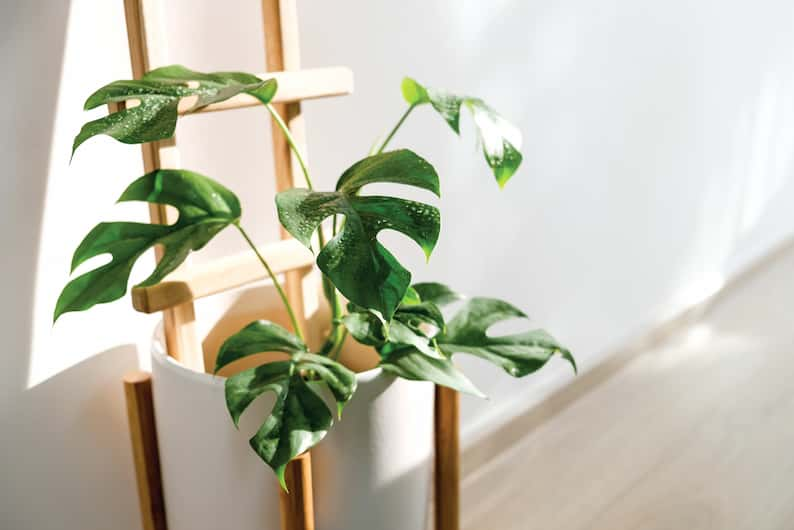
Mini Monstera can tolerate more light than true Monstera and will do well with direct light from the morning sun, but it cannot tolerate the direct rays of the hot afternoon sun. Grow it near a northern or eastern window with plenty of morning light or across the room from western or southern windows.
Water it when the soil feels dry 1 to 2 inches below the surface and then allow it to dry again before watering it again.
How many types of Monstera are there?
Monstera is a genus of flowering vines (although they rarely flower as houseplants) containing 45 accepted species with many subspecies. Unfortunately, not all species are readily available as houseplants.
How do you differentiate Monstera?
The only way to definitively differentiate Monstera plants is through genetic analysis, but that isn’t practical for the layperson. So in general practice, Monstera plants are differentiated by the leaves’ size, shape, and appearance and overall plant appearance.
This often leads to misidentification as Monstera plants change appearance as they mature. Immature leaves and plants may look like entirely different plants from their mature counterparts.
It is not uncommon for some Philodendrons, and even pothos plants, to be misidentified as types of Monstera plants. This is especially true at plant outlets with inexperienced staff. The best way to be sure what you are buying is a true Monstera variety is to buy from reputable sources.
Which is the rarest Monstera?
Some of the rarest Monstera plants include Monstera obliqua, Monstera Variegata Albo Borsigiana, and Monstera adansonii. Some consider Thai Constellation a rare variety because it is relatively new on the market and can be difficult to find.
There are many rare Monstera plants that are seldom seen in plant retail outlets. However, some rare Monstera varieties can be found in botanical gardens or sold in rare plant auctions. Variegated Monsteras appear to be some of the rarest.
Growing Monstera plants successfully is relatively easy, but don’t be mistaken into thinking Monsteras thrive on neglect. On the contrary, they require rich, well-drained soil, need plenty of indirect light to maintain their coloring and fenestrations, and are susceptible to root rot if left in soggy soil.
If you choose to grow Monstera plants expect to devote some time to their care each week. Regular watering, adequate light, and occasional fertilizing are vital to growing healthy Monstera plants.
